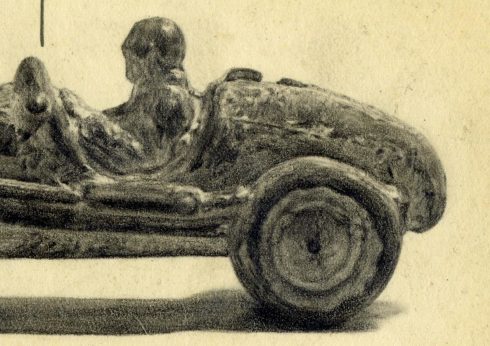The death of Bradstreet Parker of Salem in September of 1918 was not only tragic but representative: of those many young American men who rushed to fight in the Great War, only to die before they left these shores from disease, of the lethal impact on youth of this particular form of influenza, and of the confusion that reigned in that frantic fall. Mr. Parker is reported to have died at home, in the hospital, in his training camp, from both influenza and pneumonia. We know more about Bradstreet Parker because he was the son of a notable man, George Swinnerton Parker, the founder of Parker Brothers in Salem, but several young Salem men from less notable families who signed up in 1918 also died “in training”: charting their deaths is like mapping the course of the pandemic. Omer Morency died at the Chelsea Naval Hospital, where the second wave of the “Spanish Flu” began, Herbert Street next-door neighbors Joseph F. Murphy and Konstanty Wesolowski both died at Fort Devens, often referred to as “ground zero” of the pandemic, along with Salvatore Terranova and John Butler, while John McDonald died at Camp Upton in Long Island, another center of influenza infection.
 Red Cross Nurses assemble masks at Camp Devens, October 1918. National Archives and Records Administration
Red Cross Nurses assemble masks at Camp Devens, October 1918. National Archives and Records Administration
I’ve been collecting stories and data about these men for a project initiated by the Mayor of Salem, Kimberley Driscoll, designed to provide context (and perhaps provide inspiration) for our presiding epidemic from past episodes of adversity in Salem which drew the community together: all of the assembled information on the twentieth-century’s four-horsemen-esque storm of disease, death, war (+fire) is at Preserving Salem/SalemTogether. It’s a bit of a slapdash effort, falling short of what a real historical museum could and would do, but as the quest for historical perspective is a constant mission for me I am happy to participate. I’m pretty familiar with Salem’s experience of war and fire, but epidemics are new ground, and the Influenza Pandemic of 1918-1919 is particularly challenging territory. It’s almost impossible to gauge in the aggregate, as the numbers are so large and approximate, so looking at how the death of just one man, in this case Bradstreet Parker, was reported is illustrative. Massachusetts doctors were not ordered to record “influenza” as a cause of death until mid-October of 1918, more than a month after the pandemic began, and the virus often induced pneumonia, which was then recorded as the cause of death. These factors explain the not-necessarily conflicting reports of Mr. Parker’s death, and the wide estimates of influenza mortality at the local, state, national and even international level. This year-end survey of Massachusetts Vital Statistics for 1918 provides another example: influenza deaths are listed as 13,783 and pneumonia at 10,339, but the preceding TEN pages and graphs all list alternative causes of death which were induced by influenza, so that 13,783 number could be much larger.

Which of course leads me to the observation that the more you focus on the numbers, the more you lose sight of the human loss—a lesson I’ve learned many times over while teaching courses in which plague tears the fabric of society every generation or so. Bradstreet Parker was not just a statistic, nor were Omer Morency, Joseph Murphy, Konstanty Wesolowski, Salvatore Terranova, John Butler or John McDonald (who all, thankfully, have veterans’ squares dedicated to their name and sacrifice). Who was Bradstreet Parker? He strikes me as a young man in a hurry: he left Harvard to work in the family business at the end of his sophomore year and to get married: to the former Ruth Mansfield of Brookline. And then the war came: he entered an officers’ training school in upstate New York and then the U.S. Naval Aviation Detachment at MIT while she trained to be an ambulance driver with the Red Cross. In August and September, the MIT Aviation Detachment became another early hotspot of influenza infection: 220 of Parker’s fellow trainees came down with the flu. Both Parkers became ill in mid-September: he died on September 21 and she survived, appearing as “Mrs. Bradstreet Parker” in the Boston society columns for the next five years or so. Mr. and Mrs. George S. Parker lost their other son, Richard, only three years later when he died in an airship accident in France, and both forever-young men, along with their entrepreneurial father, are memorialized by a stained-glass window commissioned for the First Church of Salem by Grace Parker following the death of her husband in 1952. She chose a Camelot theme, which strikes me as most appropriate, especially as the first Parker Brothers version of the game was called Chivalry.


 Bradstreet Parker at MIT in the summer of 1918; and in September 24 and 25 Boston Daily Globe articles reporting his death; Ruth Parker (center right) demonstrating her ambulance service training in August of 1918, Boston Daily Globe; the Parker Brothers board game “Chivalry”, 1890s, New York Historical Society Collections.
Bradstreet Parker at MIT in the summer of 1918; and in September 24 and 25 Boston Daily Globe articles reporting his death; Ruth Parker (center right) demonstrating her ambulance service training in August of 1918, Boston Daily Globe; the Parker Brothers board game “Chivalry”, 1890s, New York Historical Society Collections.




















